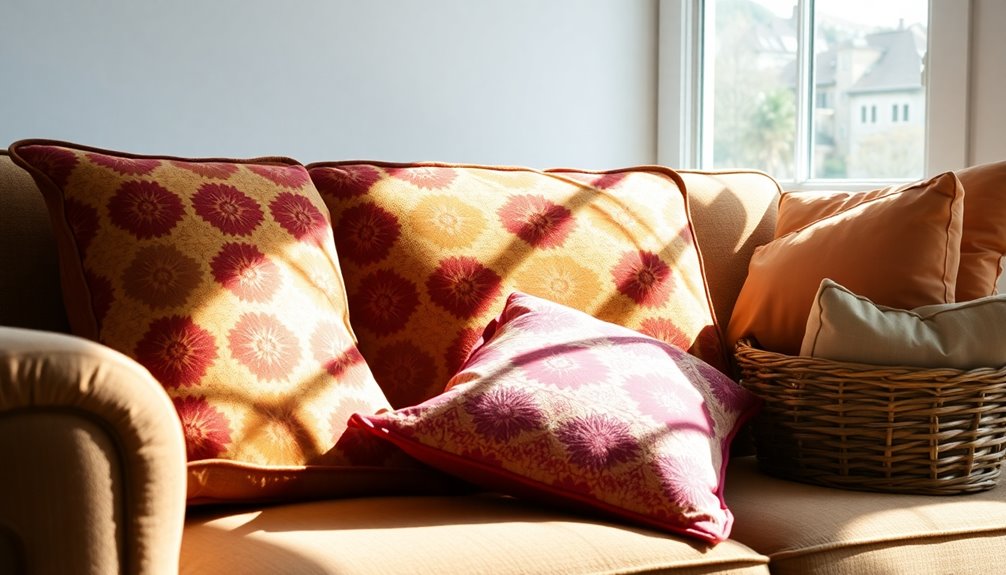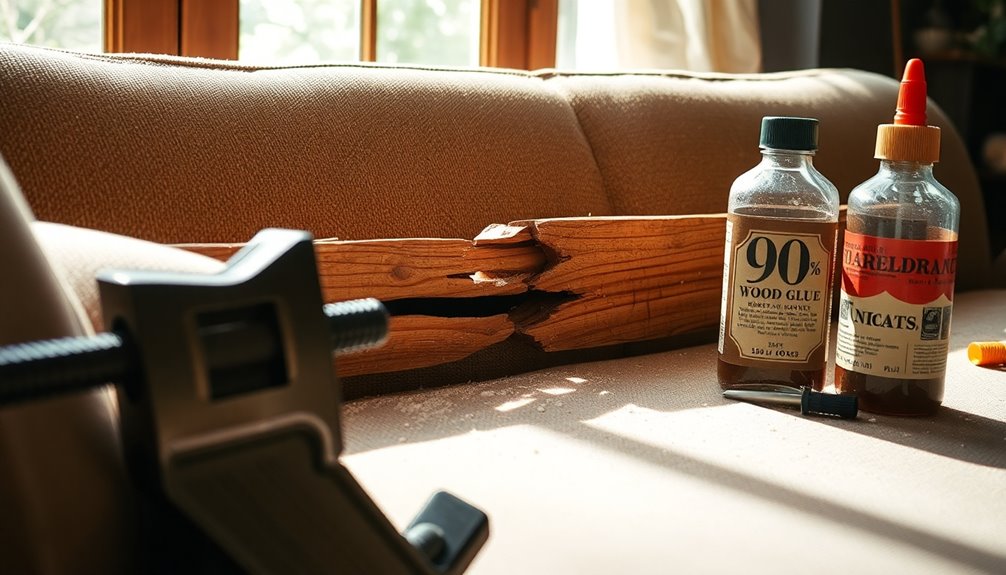To keep your sofa cushions from sagging, make regular fluffing a habit. Fluff them every few weeks to restore shape and redistribute the filling. Rotate and flip the cushions every one to two months to ensure even wear. Inspect for any signs of wear and tear regularly, and address issues promptly. Consider using high-density foam inserts for better support and add extra stuffing if needed. Protect your cushions with quality covers to prevent dirt and moisture buildup. By following these steps, you'll maintain your cushions' shape and comfort; there's more helpful information just ahead.
Key Takeaways
- Regularly fluff and rotate cushions every 1-2 months to prevent compaction and ensure even wear.
- Upgrade to high-density foam inserts for better support and longevity, combating sagging issues effectively.
- Reinforce cushion frames with plywood or Luan boards for added stability and minimize deformation.
- Use protective covers to shield cushions from dust, spills, and pet hair, maintaining their shape.
- Store cushions vertically in a cool, dry place with breathable covers to prevent compression and mold.
Introduction
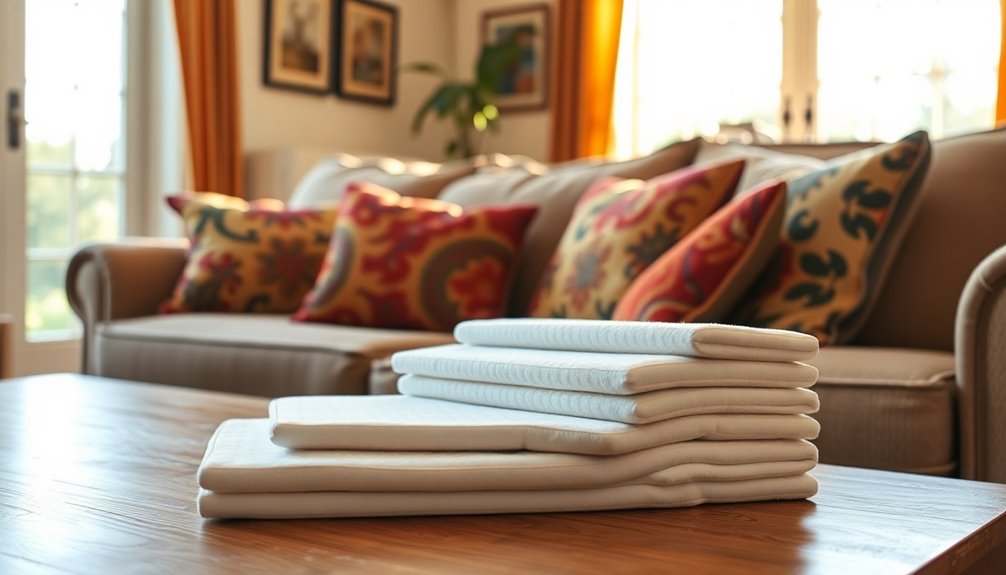
Keeping your sofa cushions looking fresh and firm requires a bit of routine care. You'll want to focus on regular cushion fluffing, use fabric-specific cleaning techniques, and know how to treat wine spills effectively. With these simple steps, you can keep your cushions in great shape for years to come.
Routine Cushion Fluffing
To maintain the comfort and appearance of your sofa cushions, regular fluffing is essential. This simple act helps redistribute the filling, preventing it from becoming compacted and ensuring your couch cushions retain their shape and loft over time. Aim to fluff your cushions every few weeks; this routine can significantly prolong their lifespan and keep them looking inviting.
You can enhance the plumpness and comfort of your cushions by lightly beating or shaking them. This not only makes your sofa more appealing for seating but also helps prevent sagging. Incorporating fluffing into your cleaning routine is a practical maintenance strategy that pays off in the long run.
While you're fluffing, consider using a vacuum attachment to remove dust and debris. This not only keeps your cushions looking clean but also contributes to their overall hygiene. By dedicating just a few minutes every few weeks to fluffing your couch cushions, you can effectively reduce the risk of sagging and maintain a cozy, inviting space in your home. Regular attention to your cushions ensures they remain a comfortable spot for relaxation and gatherings.
Fabric-Specific Cleaning Techniques
Choosing the right cleaning method for your sofa cushions is crucial to preserving their appearance and longevity. Different fabrics require specific cleaning techniques to avoid damage and maintain quality. For instance, if your cushions are made of microfiber, you can easily clean them with a damp cloth and mild soap. Always check the care label to be sure.
Cotton and linen can often be machine washed, but air drying is recommended to prevent shrinkage and maintain shape. When dealing with velvet, opt for spot cleaning using a soft brush or cloth, as water can leave unsightly watermarks.
If your cushions are crafted from synthetic fabrics like polyester, you're in luck! These are generally more durable and can be cleaned with a vacuum and mild detergent, making them easier to maintain over time. Additionally, many modern cleaning products are designed to be eco-friendly and effective, helping to protect your cushions while being kind to the environment.
Treating Wine Spills Effectively
Accidents happen, and when a wine spill occurs on your sofa cushions, quick action is key to preventing lasting damage. Start by grabbing a clean cloth and blotting the stained area to absorb as much liquid as possible. Don't rub, as this can push the wine deeper into the cushion.
Next, create a cleaning solution using one part white vinegar and two parts water. Gently dab this mixture onto the stained area; the acidity helps neutralize the wine and lift the stain. If the stain persists, sprinkle baking soda over the damp area after treating it with the vinegar solution. The baking soda will absorb any remaining moisture and odors, making it easier to clean up.
Before applying any cleaning solution, always test it on a hidden part of the fabric to ensure it won't cause discoloration. Once you've treated the stain, ensure the couch cushions are well-ventilated and allow them to dry completely. This prevents mold growth, which can further deteriorate the quality of your cushions. Regular cleaning of the cushions can also help maintain their appearance and prevent further damage. By acting quickly and following these steps, you'll keep your sofa looking its best.
Cushion Storage When Not In Use
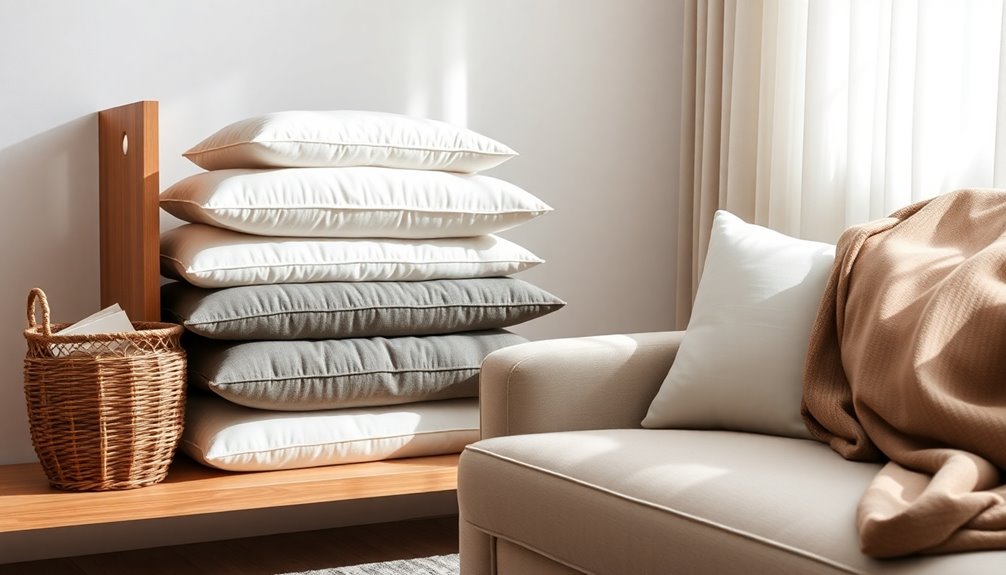
When you're not using your sofa cushions, smart storage can make a big difference. Consider using scratch-resistant fabric choices and stylish slipcovers to keep them protected and looking good. You might also want to invest in protective furniture covers to shield your cushions from dust and moisture while they're stored away.
Scratch-Resistant Fabric Choices
A variety of scratch-resistant fabrics, such as microfiber and polyester blends, can significantly enhance the durability of your sofa cushions. These durable materials are designed to withstand daily wear and tear, especially if you have pets or kids. By opting for these fabrics, you can prevent premature wear and keep your cushions looking fresh for longer.
Using cushion covers made from scratch-resistant fabrics adds an extra layer of protection, allowing for easy cleaning and replacement when needed. When your cushions aren't in use, consider storing them in breathable fabric bags. This prevents dust and moisture from accumulating, ultimately extending their lifespan and maintaining their shape.
Utilizing storage solutions, like under-bed containers or dedicated cushion storage bins, can keep your sofa cushions organized and shielded from environmental factors. Additionally, incorporating Waldorf toys into your child's playtime can enhance their imaginative experiences, much like how you can create a protected environment for your cushions. Make sure to regularly clean your scratch-resistant fabrics with suitable cleaners to maintain their appearance and integrity. By combining these storage methods with the right fabric choices, you'll ensure your sofa cushions remain in great condition, ready to provide comfort and style whenever you need them.
Opt for Stylish Slipcovers
Enhancing your sofa's style and longevity can be as simple as opting for stylish slipcovers. These versatile additions not only protect your cushions from wear and tear but also offer a fresh aesthetic, allowing you to switch up your decor with the seasons. Many slipcovers are crafted from stretchable, durable fabrics that help maintain your cushions' shape, effectively reducing sagging over time.
When your cushions aren't in use, slipcovers can neatly store them, preventing dust accumulation and protecting against potential damage from pets or spills. Choosing slipcovers with zippers or elastic bottoms ensures a snug fit, enhancing overall cushion support and minimizing the likelihood of slipping.
Regularly washing your slipcovers keeps them looking fresh and hygienic, while also giving you a chance to check for any underlying issues with your cushions. This proactive approach not only preserves the appearance of your sofa but also extends its lifespan. So, if you're looking to enhance both the style and durability of your sofa cushions, investing in high-quality slipcovers is a smart choice. You'll enjoy a more vibrant living space while keeping your cushions in prime condition. Additionally, incorporating natural materials in your slipcovers can enhance their durability and comfort, aligning with the principles of modern farmhouse style.
Using Protective Furniture Covers
To keep your sofa cushions in top shape, using protective furniture covers is essential, especially when they're not in use. These covers act as a shield against dust, spills, and pet hair, significantly reducing wear and tear that can lead to sagging over time. By investing in high-quality, breathable fabric cushion covers, you can maintain cushion shape and prevent moisture accumulation that degrades foam and stuffing materials.
When you store your cushions, make sure to keep them in a cool, dry place with covers to avoid compression or misshaping. This simple step can prolong the lifespan of your cushions. Additionally, regularly removing and washing your cushion covers minimizes accumulated dirt and allergens, maintaining the integrity of the cushions beneath.
For optimal protection, consider custom-fit covers that provide better stability for your cushions. This tailored approach not only enhances the look of your furniture but also helps reduce the frequency of sagging issues significantly. By taking these precautions, you can enjoy your sofa cushions for years to come, ensuring they remain comfortable and support your seating needs. Furthermore, maintaining an organized environment contributes to your overall emotional well-being, as it fosters a sense of calm and order in your living space.
Cushion Support Enhancements

To keep your sofa cushions in top shape, you need to address not just the cushion support but also the frame integrity and fabric condition. Consider how cushion rejuvenation techniques can breathe new life into worn-out cushions, ensuring they maintain their form and comfort. By focusing on these aspects, you can significantly enhance your sofa's overall durability and appearance. Additionally, ensuring proper maintenance through regular updates on cushion policies can prolong the lifespan of your furniture.
Cushion Frame Integrity Problems
A sturdy cushion frame is essential for preventing sagging and ensuring your sofa remains comfortable over time. Maintaining frame integrity is crucial; damaged or weakened frames can lead to sagging couch cushions and discomfort. Regularly inspect your sofa for signs of wear, such as loose joints or broken springs, to identify issues early.
One effective way to enhance your frame's durability is by reinforcing the frame with additional support, like plywood or Luan boards. This creates a stable base for your cushions, preventing them from sinking. Additionally, consider using cushion supports, such as the HAVARGO couch cushion support, which utilizes high-density foam to maintain shape and prevent sagging.
Another simple solution is to employ non-slip furniture pads. These can secure cushions in place, preventing them from sliding off the frame and contributing to sagging over time. By focusing on the integrity of your cushion frame and using the right supports, you can significantly extend the life of your sofa and keep those cushions looking and feeling their best.
Cushion Fabric Revitalization
Revitalizing your sofa cushions starts with selecting the right support enhancements to restore their shape and comfort. To effectively fix sagging couch cushions, consider using high-density foam cushion supports. Opt for pieces measuring 20×20 inches and 2 inches thick, as they provide the stability and firmness needed to combat sagging in the first place.
Incorporating bamboo charcoal into your cushion supports can enhance the experience further. This material absorbs moisture and prevents odor buildup, keeping your couch cushions fresher for longer. Additionally, using mechanical principles and arc-shaped cutting technology in your supports offers targeted lift, addressing those visible indents that can form over time.
To ensure your foam support stays in place, regularly use an anti-slip cloth. This will reduce movement and maintain the integrity of your cushion setup. Finally, when you purchase vacuum-packed cushion supports, remember to let them expand fully overnight before installation. This way, they'll provide the adequate support you need from the start, making your sofa a comfortable haven once again. Furthermore, maintaining a clean and safe environment for your cushion setup can enhance the longevity and comfort of your sofa.
Cushion Rejuvenation Techniques
Enhancing the longevity of your sofa cushions requires regular attention and a few effective techniques. To prevent sagging, start by implementing a routine to rotate and flip your cushions every 1-2 months. This ensures even wear and helps them regain their original shape.
If you're noticing your cushions are losing their support, consider upgrading to high-density foam inserts. These not only rejuvenate your sagging couch but also provide better support and longevity compared to lower-quality materials. You can also add extra stuffing like poly-fill or fiberfill to your existing cushions, layering it in for enhanced firmness and lift.
Another quick fix is to use sofa toppers, which can enhance both the firmness and plushness of your cushions without altering their structure. They’re a temporary solution that can significantly improve comfort. Whether you’re hosting guests or simply seeking a cozier spot to relax, these toppers can make a noticeable difference. In addition to their convenience, they are available in various materials, allowing you to choose one that best suits your preferences. By adding a sofa topper, you can effectively improve your sofa bed comfort and create a more inviting atmosphere in your living space.
Finally, don't forget to regularly beat and fluff your cushions. This simple act redistributes the filling, restoring their shape and preventing the materials from compacting. With these techniques, you can keep your sofa cushions looking and feeling great for years to come. Additionally, ensuring proper maintenance can lead to enhanced hygiene through reduced dust and allergens in your living space.
Cushion Shape Alteration Options
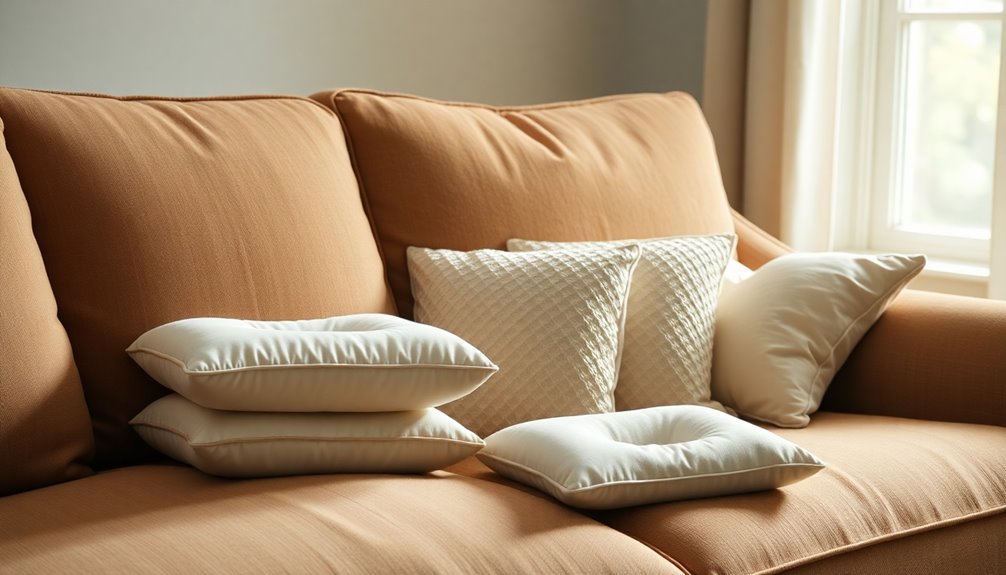
Sofa cushions can lose their shape over time, but there are effective ways to restore them. One of the simplest methods is flipping and rotating your cushions every 1-2 months. This practice redistributes wear, ensuring that all areas receive equal pressure and preventing uneven sagging.
If your cushions are still sagging, consider re-stuffing options like adding high-density foam or fiberfill. These materials can enhance support and comfort, bringing back the plushness you desire. You might also explore layering materials such as batting and foam to create a customized cushion feel, balancing firmness and softness for a better seating experience.
For added stability, incorporating cushion supports underneath can provide the lift your cushions need, effectively counteracting sagging issues. If you're looking for quick fixes, temporary solutions like sofa toppers can be placed on existing cushions. They offer immediate support and comfort without altering the original structure of your cushions, making them a great stopgap measure.
Seasonal Storage Solutions
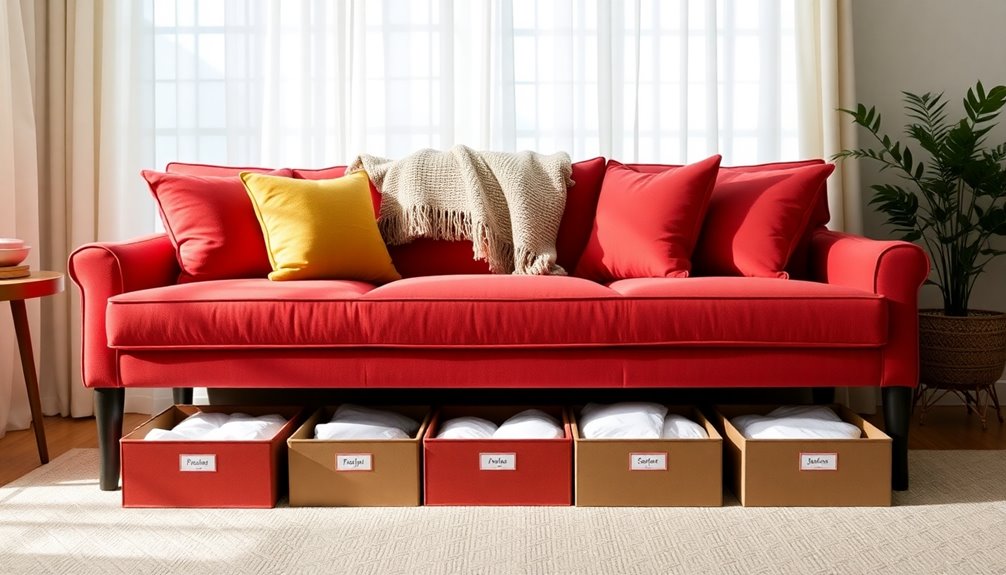
When it comes to maintaining your cushions, seasonal storage plays a key role in preserving their shape and quality. Before you tuck away your couch cushions, make sure they're clean and dry. This helps prevent any mold or mildew growth that can occur in damp conditions. Invest in breathable storage covers or bags to shield your cushions from dust, moisture, and pests.
Use a stacking technique that involves storing cushions vertically rather than piling them on top of each other. This method keeps their shape intact and prevents compression. Temperature control is also crucial; make sure to keep your stored cushions in a climate-controlled environment. Extreme temperatures can degrade the foam materials over time, leading to sagging.
Don't forget about regular checks! Periodically inspect your stored cushions for any signs of wear or damage. Catching issues early allows for timely maintenance, which can save you from bigger problems later on. By following these seasonal storage solutions, you'll ensure that your couch cushions stay in great shape, ready for use when the season calls for them.
Conclusion

Ultimately, keeping your sofa cushions in top shape requires a proactive approach to maintenance. By regularly rotating and flipping your couch cushions every few months, you can effectively distribute wear and extend their lifespan. This simple habit prevents sagging and maintains comfort. Additionally, don't forget to fluff and beat the cushions periodically; this helps restore their shape and redistributes compacted fillings.
Investing in high-density foam inserts or cushion supports is another smart move. These durable reinforcements can significantly reduce sagging over time. To further protect your investment, use protective covers and ensure even weight distribution across your cushions. This minimizes localized wear and tear, keeping your cushions looking new for longer.
Lastly, make it a point to regularly clean and inspect your cushions for signs of wear. Early detection allows for timely repairs or re-stuffing, preventing minor issues from becoming major problems. By following these guidelines, you'll not only preserve the appearance of your sofa but also enhance your comfort. With a little effort, you can keep your couch cushions in great condition for years to come.
Frequently Asked Questions
How Do I Make My Couch Cushions Not Sag?
To make your couch cushions not sag, start by regularly rotating and flipping them every few months. This helps distribute weight evenly and prevents wear. Fluffing and beating them occasionally can also restore their shape. If they're still sagging, consider re-stuffing with high-density foam for better support. Adding cushion supports underneath can give them a lift. Finally, invest in high-quality furniture to reduce sagging and extend the life of your cushions.
Why Does My Couch Feel Like It's Sinking?
Your couch feels like it's sinking because of several factors. Over time, daily use compresses the foam, leading to loss of support. If your cushions use low-quality materials, they're more likely to break down, making you feel that sinking sensation. Also, sitting in the same spot consistently wears out the cushions unevenly. Lastly, age plays a role; older sofas often have worn-out foam and springs, contributing to that uncomfortable feeling.
Is There a Way to Make Couch Cushions Firmer?
You can definitely make your couch cushions firmer! Start by re-stuffing them with high-density foam or adding poly-fill to boost support. Regularly fluff and beat the cushions to redistribute the filling. Consider using cushion supports like rigid panels to elevate them. Rotating and flipping cushions every few months helps prevent uneven wear. Finally, investing in quality materials ensures durability and maintains comfort, keeping your seating experience enjoyable and supportive.
How to Fix a Couch That Sinks in the Middle?
To fix a couch that sinks in the middle, start by checking the cushions for wear and replacing any worn foam with high-density inserts. You can also place plywood or Luan boards under the cushions to create a firmer base. Remember to flip and rotate your cushions every month to keep them even. If needed, consider using cushion supports for added stability, and inspect the frame and springs for any damage.
